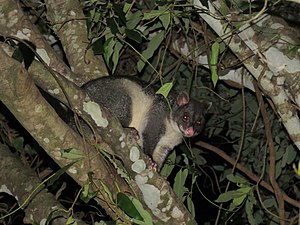Hundskusu
| Hundskusu | ||||||||||||
|---|---|---|---|---|---|---|---|---|---|---|---|---|

Image taken from Lamington National Park |
||||||||||||
| Systematics | ||||||||||||
|
||||||||||||
| Scientific name | ||||||||||||
| Trichosurus caninus | ||||||||||||
| ( Ogilby , 1836) |
The dog kusu ( Trichosurus caninus ) is an Australian marsupial that occurs in the mountains and coastal plains of eastern Australia and on Fraser Island . The distribution area extends from southeast Queensland to south of Sydney in New South Wales . To the south of this is the distribution area of the very similar and closely related Cunningham kusus ( Trichosurus cunninghami ), whose population was formerly assigned to the dog kusus , but which has been an independent species since 2002.
features
Dog kusus reach a head body length of 40 to 55 cm, have a 34 to 42 cm long tail and reach a weight of 2.5 to 4.5 kg. In contrast to Fuchskusu , they do not show any pronounced sexual dimorphism . The fur of the dog cousin is dark gray in most cases, but a blackish morph is quite common. The bushy tail is black. The ears are rounded and smaller than the pointed ears of the fox kusu. The Hundskusu can be distinguished from the Cunningham Kusu by its smaller ears, smaller hind feet and a longer tail.
Habitat and way of life
The dog kusu occurs in subtropical rainforests and humid evergreen forests and prefers areas with many tree hollows. The animals are nocturnal and spend the day in tree hollows, on forks or in the middle of epiphytes. Hundskusu mainly feed on leaves, with the silver acacia ( Acacia dealbata ) making up about 30 to 50% of their diet. Buds, flowers, mushrooms, lichen and sometimes bark are also consumed. Mistletoe leaves and flowers are also part of their diet. Dog kusus also go to the ground to forage and sometimes spend more than 50% of their active time there. However, they do not move more than 10 meters from the edge of the forest. The territory used by an individual is usually 5 to 7 hectares and the individual density is given as one specimen per 3 hectares. Various calls are used to communicate with them, as well as scent markings secreted by secretions from glands on the chin, chest and cloaca , which also provide information about territorial limits, age and willingness to conceive.
Females reach sexual maturity at the age of two, but usually do not have their first young animal until the age of three. Most young animals are born in March, April or May, only a few in other months. Only one young animal is born per birth. If this dies shortly after birth, the female can give birth to another. The gestation period is 15 to 17 days. The young animal then spends five to six months in its mother's pouch. After leaving it, it will drink milk from one of the teats in the bag for another two to five months. After it has become independent, the young animal remains in the mother's territory up to an age of 18 to 36 months. Females usually leave the maternal territory sooner than the males. These can live to be 12 years old, females reach a maximum of 17 years.
Predators that pursue the dog kusu are mainly the diamond python , the giant bag marten and the dingo . The Hundskusu is considered safe.
supporting documents
- ↑ a b c d e Kristofer Helgen & Stephen Jackson: Family Phalangeridae (Cuscuses, Brush-tailed Possums and Scaly-tailed Possum). In: Don E. Wilson , Russell A. Mittermeier : Handbook of the Mammals of the World - Volume 5. Monotremes and Marsupials. Lynx Editions, 2015, ISBN 978-84-96553-99-6 , p. 484
- ↑ Lindenmayer, DB; J. Dubach; et al. (2002). Geographic dimorphism in the mountain brushtail possum T. caninus : the case for a new species. Australian Journal of Zoology. 50 (4): 369-393. doi: 10.1071 / ZO01047
